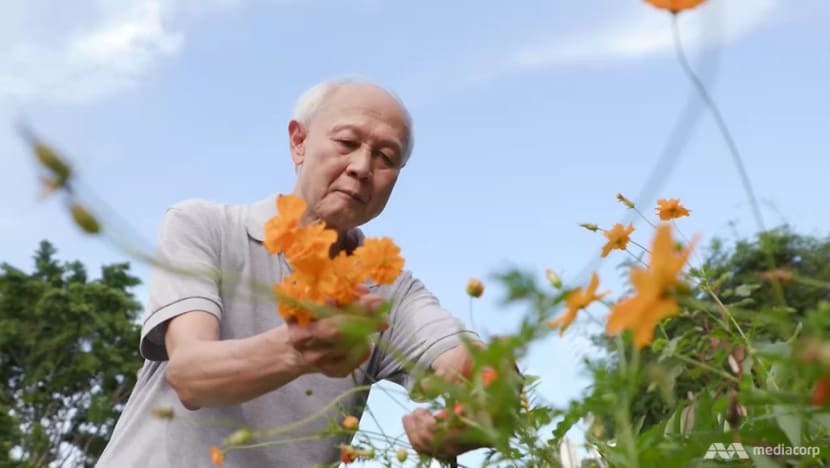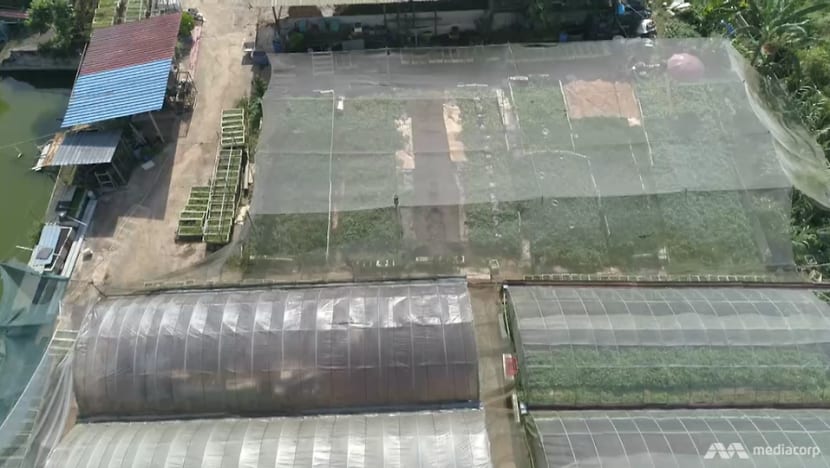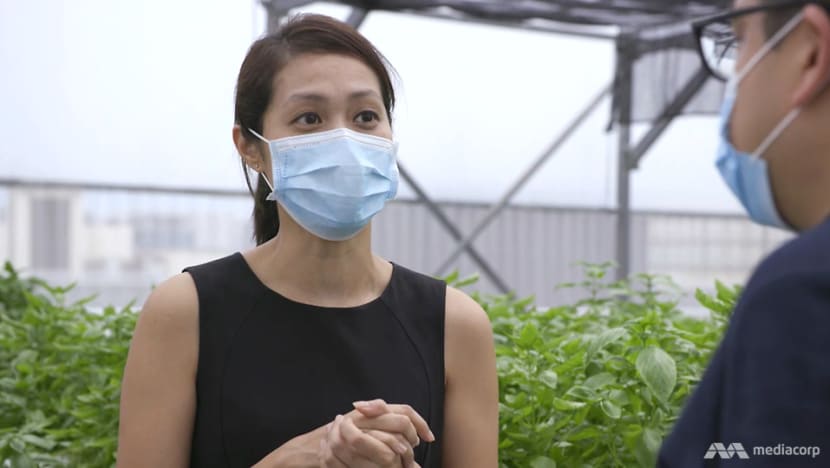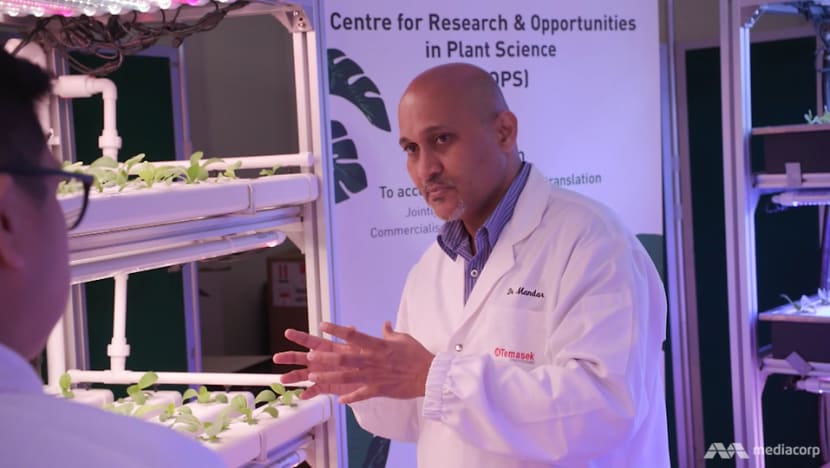Singapore’s farms face an even greater challenge in a post-COVID-19 world
A question now arises as to whether the ‘30 by 30’ food supply vision will suffice for the country. The programme For Food’s Sake! finds out what changes are needed in the growing agri-tech sector.

Figuring out new ways to increase productivity on farms is one of the challenges.

This audio is generated by an AI tool.
SINGAPORE: It is a vision that predates COVID-19. Spurred by threats like climate change, Singapore set about having 30 per cent of its food produced locally by 2030, to improve its food security.
But food security expert Paul Teng thinks the country is not going far enough with its “30 by 30” goal set in 2019.
READ: COVID-19 pandemic highlights importance of strengthening Singapore's food security, say experts
“Even if we achieve that in 10 years’ time, we’re still dependent on the rest of the world for the remaining 70 per cent. If all things are normal, then it should be enough … to create a buffer,” he says.
“But if indeed all the worst-case climate change scenarios come true, and there are many other black swan events, then we may need more than two or three months’ worth.”

The professor, an adjunct senior fellow at Nanyang Technological University’s S. Rajaratnam School of International Studies, sees COVID-19 as a “wake-up call” to do more.
“I don’t imagine that the COVID-19 pandemic will be the last time that we’ll be disrupted in terms of food supplies. … If you look around Asia at the moment, you’ve got a whole host of issues affecting us,” he notes.
“The armyworm is just one example. But there are many other pest problems, disease problems. … Anything could flare up and affect our supply chain. Then there’s also politics.”
READ: How a ‘worm’ might affect prices of cereal, toothpaste and chicken rice
There are 220 farms in Singapore as of last year, producing mainly leafy vegetables, fish and eggs.
Millions of dollars are being poured into this growing agri-food industry. But it still produces less than 10 per cent of the country’s food, and the rest is imported from more than 170 countries and regions.

Most of the farms are “not what I’d call modern farms”, says Teng, urging improvements in productivity. Not only that, other changes are also needed more than ever, the programme For Food’s Sake! finds out.
THE ISSUE OF LAND
One of Singapore’s largest producers of Asian leafy vegetables is Farm 85, which lies on 12 hectares of land in Lim Chu Kang — roughly the size of 17 football fields.
But its owner, Tan Koon Hua, who started the farm in 1991, does not think it is easy to increase production further.
“The most we can do is to find ways to prevent disruptions,” says the 52-year-old, citing the example of greenhouses, which he has built to protect his crops against changes in weather.

The other solution, he believes, is a bigger land area. One of the reasons the work on the farm is laborious is its current size, agrees his son Zach, who works there.
For example, while large farms overseas “can invest in a big tractor” to aerate the soil, Farm 85 uses hand-operated soil tiller machines, cites the 26-year-old.
Less than one per cent of Singapore’s land is used for agriculture. In recent years, new plots have been released for farming, but in smaller parcel sizes ranging from about 0.6 to two hectares.
The largest plots awarded have been about six hectares, which means farmers still need to reduce their reliance on land.
Short leases have been another disincentive to making long-term investments in better equipment or infrastructure. It is one of the reasons, along with lack of technical know-how, that farmers are not as productive they could be, according to Teng.

Today, the new plots have longer lease terms of up to 20 years, compared with previous ad-hoc lease extensions that were as short as three years.
PRODUCTIVITY PLATFORMS AND PITFALLS
To further help with productivity, the government has made several grants available since 2014. At least three are targeted specifically at the agriculture industry.
One is the Singapore Food Agency’s (SFA’s) S$63-million Agriculture Productivity Fund. It is meant for farmers to invest in more innovative systems that can boost their yield, for example under a scheme — capped at S$50,000 — for the purchase of equipment.
There is also a scheme for farmers to convert their farm into a more high-tech farming system.

To apply, the proposal they submit must include: The project’s objectives; a comprehensive description of the farming system, with the layout; brochures of the equipment; a full business plan; and a track record of the project team’s area of expertise.
For Food’s Sake! host Ming Tan was uncertain, however, whether farmers are able to “suddenly just provide this information”. “If they already knew how to do these (high-tech) things, don’t you think they’d have done them?” he questioned.
So a new type of farmer has sprung up in recent years. Ex-engineers and venture capitalists are among those who have set up tech-focused farms that do not rely on large fields.
Between 2015 and 2019, the number of vegetable farms increased from 54 to 83. Despite this increase of 54 per cent, the production of leafy vegetables rose only by 11 per cent, from 11,400 to 12,700 tonnes.

There are “still a lot of challenges on the ground”, an industry insider tells Ming. “There aren’t that many dedicated contractors who can build farms. … Almost always the infrastructure cost starts ballooning,” he says.
Plus … you need to spend time, effort and money training everyone from scratch literally. We don’t have a ready pool of skilled indoor farmers.”
In this high-tech farming space, proprietary technologies have been brought in from different parts of the world, but “these are also varied in terms of how (they’re) translated on the ground in Singapore, in the context of a tropical environment”.
“There’s a lot of clamour, sound … and hype coming,” he adds. “Still, … they all need to translate into a viable business.”
IT’S EARLY DAYS YET
According to the SFA, the outlook for high-tech farms is not bleak.

“It’s a really nascent technology and sector. And as with any other new industry, it would take time for commercial models to sort of become viable,” says SFA deputy director (Food Supply Resilience) Sim Wi Min.
“There’s almost a five-year period where they have to do construction and fine-tune their operations. So while you don’t see that corresponding amount of production, I assure you we’ll see more production in years to come.”
She acknowledges that there are “inherent risks” involved, as “technology doesn’t come cheap”. Some farms that were grant recipients, for example, have wound down earlier than expected.
“Some of them don’t make it. Sometimes it’s not because the technologies don’t work. It could be that partnerships fall through,” she adds. “But cases that are successful outweigh those who exit the industry.”

One of the success stories is ComCrop, which was one of the first to attempt rooftop farming in Singapore eight years ago. Located in a Woodlands industrial estate, its crops are grown using hydroponics instead of traditional soil-based methods.
Chief executive officer Peter Barber thinks of it as a hybrid farm, using sunlight and a greenhouse designed for constant air flow, unlike high-tech indoor farms that use artificial lights and air conditioning. And he can see why the latter might struggle.
“These two worlds (high-tech and traditional farming) have operated in isolation,” he says. “(The traditional farmers) know what they need to do to grow vegetables, but they may not be so adept on the technological side.
“Then you’ve got the tech guys who have all their artificial intelligence and their robots. … The problem is, the new guys don’t have the growing experience, and I think that’s why they’re falling down on the volume side.”

To create a flourishing industry, he says “we have to build an ecosystem”.
“Then we need the support of the food agency to make sure that Singaporean consumers see the quality, the safety and the nutritional value of what’s grown here in Singapore … and say, ‘That’s a gold standard,’” he adds.
“We still haven’t seen the full repercussions of the food supply problems that’ve been created by COVID. If we don’t change how much we’re growing here, we’re going to be paying more for food no matter which way we look at it.”
BRIDGING THE NUTRITION GAP
In the supermarket, however, some consumers have a preference for one type of vegetable over the other. Demand for vegetables from soil-based farms is higher than for those from high-tech farms, according to NTUC FairPrice, Singapore’s largest supermarket chain.
WATCH: Why aren’t Singaporeans buying more locally farmed produce? (5:25)
As a chef, Ming expected this to have something to do with taste. But in a blind taste test of bok choy (Chinese cabbage), the results were split evenly among customers at a tze char restaurant.
It turns out, however, that some people think soil-grown vegetables are more nutritious, as Ming found out when he asked on Instagram why people preferred to buy these vegetables.
Plant scientist Mandar Godge, who specialises in the study of Asian leafy vegetables, knows what is behind this partiality.
“There was a stark difference between the hydroponics-grown leafy vegetables and soil-grown (ones) five years ago, or even three years ago, in terms of the nutritional density,” says the Temasek Polytechnic researcher and lecturer.
“Now the gap is bridged. We’re looking at very improved hydroponics techniques coming in and (producing) a similar nutritional density (to that) which we get in soil-based farming.”

Over the past decade, scientists like him have been trying to supercharge hydroponics produce by, for example, customising them “based on what kinds of properties you need”, like high levels of vitamins and minerals.
Things like enzymes added to the water can “boost” the nutritional value of the leafy vegetables. Different light intensities can also make a difference in terms of the taste.
The nutritional density of the leafy vegetables in his laboratory, he says, “is much higher compared to what’s available”. And for more farms to adopt these technologies, he suggests that a “technology showcase has to be done Singapore-wide”.
THE DUTCH EXAMPLE
One country that has successfully mass-adopted technology in its farming systems, including urban farming, is the Netherlands. Despite its size, it has become the world’s second-largest food exporter by value.

Pepper farmer Ron Jansen, for example, has transformed his grandfather’s farm, Jansen Paprika — located one hour north of Amsterdam — into one of Holland’s most modern farms.
His farm, the size of eight football fields, produces more than 2,000 tonnes of peppers each year, which is 15 times more than what his grandfather grew.
To ensure optimum conditions for his plants, he uses temperature and humidity sensors, which he can track from his office. Machines do the heavy lifting. And he is looking to adopt more cutting-edge technology.
“There are tests to grow plants autonomously — so not by hand. You put your set-up in your computer, and the computer will think for you,” he cites.

Universities play an important part in Holland’s agricultural sector, whose exports last year were worth 95 billion euros (S$152 billion).
“One of the missions of the university is to set up research and demonstration centres to show the possibilities of technology … and transfer the knowledge,” says plant researcher Sjaak Bakker from Wageningen University and Research.
To facilitate this, a central organisation groups farmers according to the crops they grow, where they present their problems to researchers and government agencies, and collectively brainstorm solutions.
“Farmers can’t survive on their own. They need a certain scale in doing research and … innovation,” Bakker adds. “This is why the ecosystem in the Netherlands has come this far and is such a successful sector.”

THE NEED TO CHANGE PERCEPTIONS
There are more than 20 agricultural universities in Holland that prime people for the industry. In contrast, there are no universities or polytechnics in Singapore offering agriculture as a full-time course. Most farmhands here are foreign workers.
“Not a lot of Singaporeans want to come to a farm and work. It’s hard work, it’s all day … and you have to be here, rain or shine,” says Zach.
Although he is an anomaly, he has helped out on his father’s farm since he was in school. Bjorn Low is even more of an outlier. Eight years ago, he quit the advertising industry to become an urban farmer.
The co-founder of Edible Garden City now has a team of 40 people, with an average age of 25. He thinks it is important to change the perception of farming and to have more young people see it as a career.
WATCH: The full episode — Growing more of our own food: Can Singapore get there? (47:23)
“This is a national security issue. And so, urban farmers or agriculturalists coming up should be seen as an important part of the economy for the future,” says the 39-year-old.
"We need new ideas in this space and to encourage young people to experiment in this space and then drive other initiatives in the local agricultural industry."
He also wants consumers to “step up” for the sake of their food security in future. “Buy local food,” he urges.
“Sometimes the price points … may be five per cent, two per cent higher than things that are produced in Malaysia or Indonesia or Thailand. And consumers are not willing to fork out that additional 20 cents.”

To this end, Restaurant Labyrinth chef and owner Han Li Guang makes a point of sourcing 80 per cent of his produce — including mussels and herbs — from local farms.
The 35-year-old believes restaurants have a part to play, and can even lead the charge, in getting people to buy more local produce.
“We’re like a showroom for Singapore’s agricultural produce. … If we can convince people to ‘use local’, no matter how many per cent, it’s a good start,” he says.
“My hope for the future is … we’ll see consumption of local produce as a norm.”
Watch this episode of For Food's Sake! here. And read about how COVID-19 is a wake-up call for F&B outlets and the seven changes they can make.


















